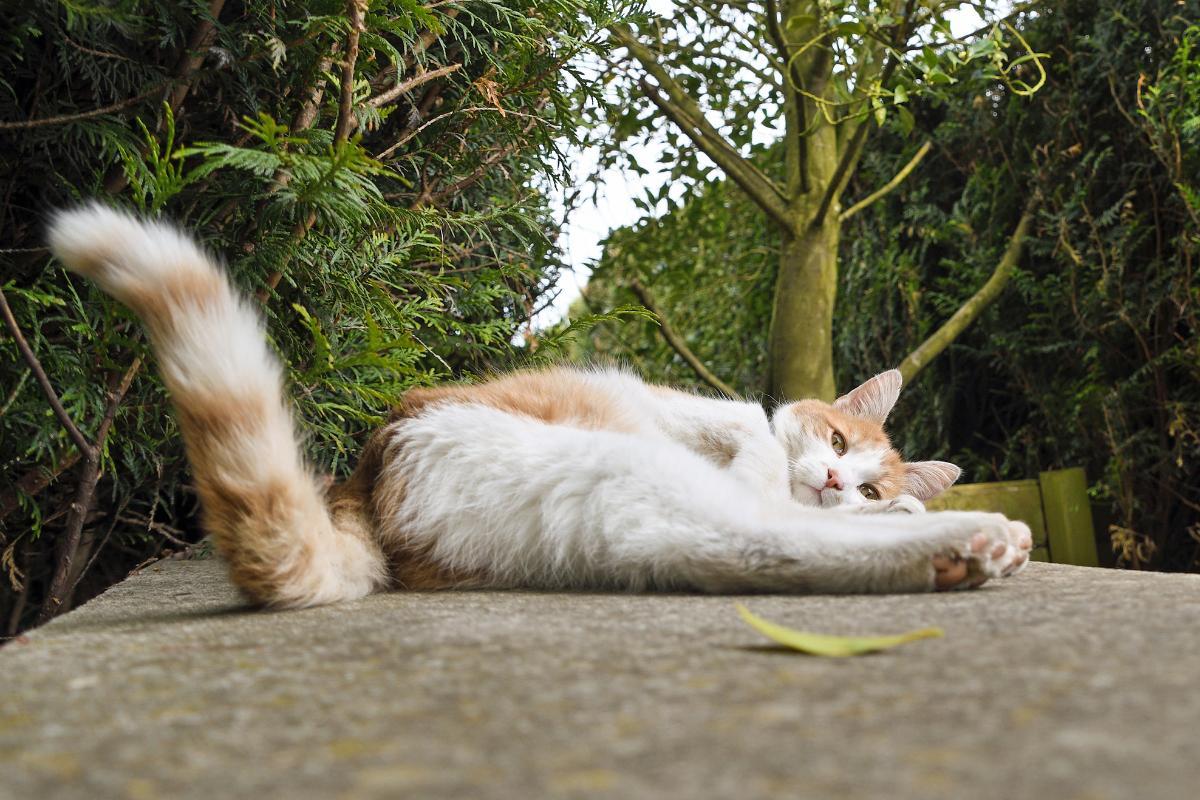Why Do Cats Wag Their Tails While Lying Down?



See files for Cats
Cat communication relies heavily on body language. Although their purr or meow can be revealing, cats can say all you need to know without making a squeak. This includes body posture, something which is particularly important when a cat meets another cat. This can tell the other feline whether it is a friendly or aggressive by how they hold their bodies. Tail movement is also another key method of communication. Whether a cat whips their tail or lets it sway softly can reveal a lot about their well-being. We also need to look at the overall context, since different combinations of postures and movement can have different meanings depending on this context.
AnimalWised looks at one such combination as we ask why do cats wag their tails while lying down? We look at the possible reasons for this specific body posture and what they might say about the cat's mood, health or well-being.
They want your attention
If your cat is lying down and wagging their tail slowly from side to side, it could be they want your attention. They are not moving the tail violently since they are trying to appease you and get on your good side. When this happens, the tail is usually relaxed and often directly touching the ground. They may also be purring and generally paying close attention to you, evening jumping up to laying down on your lap or chest.
What to do if my cat wants attention
Regardless of the context, we need to be closely attuned to our cat's needs. This will involve knowing their likes and dislikes, something which will develop over time. We will slowly get to know when they want something to eat, a petting session or something more serious. It is an excellent opportunity to strengthen your bond and enjoy some reciprocal affection.
If you find your cat is always lying down and wagging their tail, it may be you are not providing them enough attention. Different cats will need different levels of attention or interaction. In these cases, you should assess the cat's needs and ensure you are meeting them correctly. You may need to play with them more, provide them more attention or even make a change such as amending their diet.
When they are in need of attention, you may also see your cat meows at you every time they see you.
They are enjoying themselves
Another reason a cat wags their tail while lying down might be due to happiness. In these cases, you will see a similar body posture to the previous. They will be relaxed and subdued, often laying on top of you as they wag their tail from side to side. This will be in a slow and soft motion.
We can see this especially when we are with them. Knowing where and when to pet a cat will help you to have a strong bond. Conversely, if you try to pet them when they do not want attention, it can cause them stress and frustration. While you should eventually know their preferences, it can be tricky to gauge. Sometimes a cat will wag their tail swiftly when they are enjoying being petted somewhere, but they may make a similar motion if they are not wanting to be touched.
Learn more about discerning the difference with our article asking why does my cat's tail vibrate?
What to do if my cat is happy
There is nothing you need to do other than keep it up. Especially when they come to you to be petted, you simply need to know what they enjoy and let your relationship develop in a positive way. Equally, you need to be sensitive to changes in their body language which might intimate they do not want to be touched any more. You can better understand these signs with our article asking why does my cat bite me when I pet them?

They are curious
Even when at rest, a cat is attuned to their environment. This is very necessary for feral or wild cats, but even domestic cats need to feel secure wherever they are. If your cat is lying down, they may wag their tail when they spot something. If they keep lying down and wag their tail softly, it is usually a pleasant stimulus that simply piques their interest. Of they perceive a threat, they will become more alert and may even adopt a defensive posture.
What to do if my cat notices something
For a cat to be secure in their environment, they need to have peaceful surroundings. While the needs of each cat will differ according to the individual, no cat will fare well in a very stressful environment. They will need to have a place to rest and their accessories should be kept in areas without much foot traffic. Cats which have a peaceful home are more likely to respond appropriately to stimuli.
Another important factor is socialization. Cats which have poor socialization often do not know how to respond appropriately to stimuli. They perceive benign stimuli as a threat because they do not know how to respond appropriately. They can even resort to aggression in circumstances where they feel insecure or surprised. Learn how to socialize a kitten with other cats in our related guide.

They are stressed or anxious
Cats will lay down to rest, but they will also do the same when they want to protect themselves from stressful situations. Again, it is important to look at the context. They may be lying down and wagging their tail, but they will be tense and on edge. Their tail may flick back and forth with some violence, a clear sign that something is wrong.
It can be difficult for us to distinguish between happy and stressful tail movements. For this reason, we should always look at other signs a cat is stressed. If we are petting them at this point, they may even react aggressively towards us. This can happen all of a sudden. For example, cats often do not like to be stroked on their belly. If we try to stroke them here while they are lying down, they may move their tail as a signal to stop.
The cause of your cat's stress or anxiety doesn't necessarily have to have anything to do with you petting them. They may be stressed because of a change to their routine, a stranger being in the home or even loud noises from outside.
What to do if your cat is stressed
Since the cause of your cat's stress can be varied, it is important for us to make an assessment of their well-being. If the problem is all of a sudden, it is possible a physical health problem is causing them to be anxious. This will require diagnosis from a qualified veterinarian.
If a physical problem has been ruled out, we can look at their environment and routine. If we have changed anything in their routine, their stress could be a negative response. Even something as small as changing their food brand can cause stress in a cat. Some obvious causes of stress might be the arrival of a new cat into the home. In these cases, we will need to careful adjust them to each other's presence.
Sometimes it can be difficult to both isolate and treat the cause of stress in cats. For this reason, we may need to employ the help of a feline ethologist who can provide expertise to diagnose the problem and practical behavioral therapy to address it.
They are frustrated
Another situation in which a cat wags their tail while lying down is when they are frustrated. This is something which can result in the cat's tail being flat against the ground, but its movements are quick and sharp.
Frustration can be similar to stress, but the distinction we make is that a cat is frustrated because they don't understand something. This could be a reaction to something in the environment, but it could also be something we are doing. A common cause of frustration in cats is scolding by their guardians. If a cat does something that we do not like, scolding them is not an effective way to redirect their behavior.
Providing inappropriate care can also cause frustration in the cat. Cats are animals of routine and need structure. Without it, they can have behavioral problems. For example, we should feed them at the same time every day. A poor feeding schedule can cause insecurity in the cat. Similarly, we need to be consistent in our treatment. If one day we allow them to sit on the couch, but the next day we don't, they will reach negatively.
What to do if my cat is frustrated
We may not be able to train a cat in the same way as a dog, but this does not mean they do not need education. On the contrary, cats will need to learn boundaries in the home to feel secure within it. We also need to learn the boundaries of the cat. A common example is picking up a cat. Many cats do not like this behavior. If we keep doing it, they will build resentment against us.
This is why consistency is so important. We should ensure we establish a routine and stick to it. We also need to be consistent in our treatment of the animal. Do not make up arbitrary rules and expect the cat to follow them. Scolding should only be a last resort. Much more effective is to redirect unwanted behaviors. For example, if a cat keeps scratching the furniture, provide scratching posts and encourage them to be used instead.

Other reasons why cats wag their tail while lying down
As you can see, there are several possible explanations why a cat wags its tail while sleeping or lying down. Understanding the cause will require looking at the context of this behavior. In context, this same movement can be a sign of either positive or negative emotions. Our response as guardians must be aligned with the cause or motivation for this behavior to be effective.
If you would like to delve deeper into the fascinating world of cat body language, you should take a look at our article which explains why a cat wags its tail.

If you want to read similar articles to Why Do Cats Wag Their Tails While Lying Down?, we recommend you visit our Basic care category.








